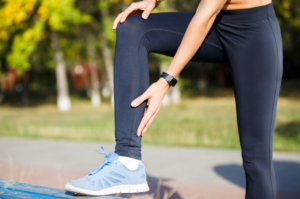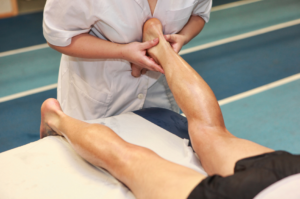Why Won’t My Achilles Tendon Stop Hurting?
January 8, 2021

 A one-off pain at the back of your heel at your Achilles tendon that starts but then shortly subsides for good is one thing. Ongoing Achilles pains and problems that keep reappearing – or even worse, never truly go away – takes the problem to a whole new level of discomfort, frustration and pain.
Ongoing Achilles pain can leave you unable to participate in sports, move efficiently at work, and even take your dog to the park. As Achilles pain is a common problem here in New Zealand, and ACC research shows that tendon injuries are on the rise, we’re filling you in on what’s going on when you have ongoing Achilles pain at the back of the heel, what’s causing it, and what you can do to prevent it from continuing to give you grief for years to come.
A one-off pain at the back of your heel at your Achilles tendon that starts but then shortly subsides for good is one thing. Ongoing Achilles pains and problems that keep reappearing – or even worse, never truly go away – takes the problem to a whole new level of discomfort, frustration and pain.
Ongoing Achilles pain can leave you unable to participate in sports, move efficiently at work, and even take your dog to the park. As Achilles pain is a common problem here in New Zealand, and ACC research shows that tendon injuries are on the rise, we’re filling you in on what’s going on when you have ongoing Achilles pain at the back of the heel, what’s causing it, and what you can do to prevent it from continuing to give you grief for years to come.
Why do I have Achilles pain at the back of my heel?
Your Achilles tendon is the largest and strongest cord-like tendon in your body. It connects the muscles at the back of your leg, your calves, to the back of the heel bone. More than that, it helps you to efficiently take each step, point your toes to the ground and push off as you run. Problems with the Achilles tendon falls under multiple names which describe different features of the injury process:- Tendinitis – this refers to the inflammation of a tendon, usually in the initial stages of overuse or injury
- Tendinosis – this refers to a non-inflammatory degeneration of a tendon, usually after the initial inflammation has settled and the damaged tissue remains
- Tendinopathy – this refers to the disease process of the tendon, and in the case of the Achilles tendon, typically describes chronic degeneration of the tendon
What causes Achilles pain and injuries?
Achilles pain most often starts when the tendon is overloaded and stressed or strained past the point that it can safely handle. This results in micro-tears and damage in the tendon. In severe cases, partial tears may develop in the tendon, which may then progress to a rupture. Common causes of overloading include:- Excessive running and jumping
- Increasing training intensity and duration without adequate warm-up and preparation
- Tight calf muscles
- Abnormal foot biomechanics and poor foot posture that exacerbates the pull on the calves and Achilles tendon
- Inadequate warm-ups and recovery techniques
Why won’t my Achilles injury get better?
 If your Achilles pain won’t go away or stay gone, it’s a big sign to us that one or more of the causes of the overuse and stress are still present. You may try resting more and taking it easy on your feet, but if every time you walk your tight calf muscles and poor foot posture are straining the tendon, it will continue to incur damage and never truly get better.
The only way to get rid of the pain for good – and keep it gone – is to understand all the factors that are contributing to the pain, and address them accordingly. This is one of our areas of expertise here at Perform Podiatry. We start with a comprehensive biomechanical assessment, and then put the right measures in place so that the tendon can heal appropriately without incurring additional damage.
If your Achilles pain won’t go away or stay gone, it’s a big sign to us that one or more of the causes of the overuse and stress are still present. You may try resting more and taking it easy on your feet, but if every time you walk your tight calf muscles and poor foot posture are straining the tendon, it will continue to incur damage and never truly get better.
The only way to get rid of the pain for good – and keep it gone – is to understand all the factors that are contributing to the pain, and address them accordingly. This is one of our areas of expertise here at Perform Podiatry. We start with a comprehensive biomechanical assessment, and then put the right measures in place so that the tendon can heal appropriately without incurring additional damage.
What can you do at home to help prevent your Achilles pain from coming back?
There are a few things we recommend to reduce your likelihood of injuring your Achilles tendon:- Have a good warm-up and cool-down routine, focusing on effectively stretching your calves and Achilles
- Retrain your gait if you know you have some biomechanical or alignment issues with your feet or legs. If you’re unsure about the biomechanics of your feet and legs, have it assessed by your podiatrist. If your feet and legs regularly feel sore and achy, it’s a good indication that this will be worthwhile for you
- Don’t jump between low-intensity to high-intensity activity too quickly. If you’re just making the transition from casual to more strenuous exercise, ease into it. If it’s been a year since you were truly physically active, take it slow and don’t rush
- Check your footwear. Our footwear serves an important function to support and stabilise our feet. Having your foot supported and contained inside the shoe, when it’s a good, strong shoe, limits the side-to-side motion of your foot and works to better control the steps taken, easing the strain on muscles and tissues including the Achilles tendon
- Prioritise stretching and strengthening daily. This helps to optimise your lower limb health and thereby reduce future injury. Eccentric loading is a great strategy that strengthens tissues while lengthening them, helping you to absorb shock and better controlling the motion at your heel
- Don’t ignore niggles or minor pain. This is perhaps one of the most important things you can do to prevent major problems developing. Many people will ignore minor niggles and aches in the hope they will resolve on their own. While this may be the case for some, for others, the injury will simply continue to worsen and then tendon will continue to degenerate until you have a much larger problem with a much larger recovery time.
